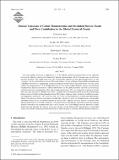Diurnal Variations of Global Thunderstorms and Electrified Shower Clouds and Their Contribution to the Global Electrical Circuit
Author(s)
Liu, Chuntao; Williams, Earle R.; Zipser, Edward J.; Burns, Gary
DownloadLiu-2010-Diurnal Variations o.pdf (1.847Mb)
PUBLISHER_POLICY
Publisher Policy
Article is made available in accordance with the publisher's policy and may be subject to US copyright law. Please refer to the publisher's site for terms of use.
Terms of use
Metadata
Show full item recordAbstract
The long-standing mainstay of support for C. T. R. Wilson’s global circuit hypothesis is the similarity between the diurnal variation of thunderstorm days in universal time and the Carnegie curve of electrical potential gradient. This rough agreement has sustained the widespread view that thunderstorms are the “batteries” for the global electrical circuit. This study utilizes 10 years of Tropical Rainfall Measuring Mission (TRMM) observations to quantify the global occurrence of thunderstorms with much better accuracy and to validate the comparison by F. J. W. Whipple 80 years ago. The results support Wilson’s original ideas that both thunderstorms and electrified shower clouds contribute to the DC global circuit by virtue of negative charge carried downward by precipitation. First, the precipitation features (PFs) are defined by grouping the pixels with rain using 10 years of TRMM observations. Thunderstorms are identified from these PFs with lightning flashes observed by the Lightning Imaging Sensor. PFs without lightning flashes but with a 30-dBZ radar echo-top temperature lower than −10°C over land and −17°C over ocean are selected as possibly electrified shower clouds. The universal diurnal variation of rainfall, the raining area from the thunderstorms, and possibly electrified shower clouds in different seasons are derived and compared with the diurnal variations of the electric field observed at Vostok, Antarctica. The result shows a substantially better match from the updated diurnal variations of the thunderstorm area to the Carnegie curve than Whipple showed. However, to fully understand and quantify the amount of negative charge carried downward by precipitation in electrified storms, more observations of precipitation current in different types of electrified shower clouds are required.
Date issued
2010-02Department
Massachusetts Institute of Technology. Department of Civil and Environmental Engineering; Parsons Laboratory for Environmental Science and Engineering (Massachusetts Institute of Technology)Journal
Journal of the Atmospheric Sciences
Publisher
American Meteorological Society
Citation
Liu, Chuntao et al. “Diurnal Variations of Global Thunderstorms and Electrified Shower Clouds and Their Contribution to the Global Electrical Circuit.” Journal of the Atmospheric Sciences 67.2 (2010): 309-323. © 2010 American Meteorological Society.
Version: Final published version
ISSN
1520-0469
0022-4928